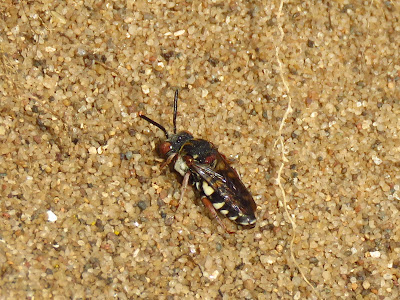 A breezy day, mild and starting cloudy but then clearing up. The tide was still very high when we got to Skeffling clough. As I climbed the Humber bank I spotted a dozen Little Egrets roosting by the creek, which soon moved upstream.
A breezy day, mild and starting cloudy but then clearing up. The tide was still very high when we got to Skeffling clough. As I climbed the Humber bank I spotted a dozen Little Egrets roosting by the creek, which soon moved upstream.


In the distance there was a large flock of Shelduck on the shore and similar numbers roosting on the water. Soon, as we walked south along the bank, waders started passing, Dunlin, Curlew, Redshank. Two cormorants moved upstream, followed by a surprise Guillemot. Inland, there was plenty of raptor action: A Kestrel, several Buzzards, a Marsh Harrier, a Sparrowhawk and then, sitting on some stubbles, a Merlin. We watched it for a long time, until if flew off and moved over the bank to the Humber.
A Guillemot passes by some Shelduck up the Humber.
Merlin.
Merlin.
The Merlin sat on this field, looking like a clod of earth.
After watching the Merlin we turned to the Humber. The ebbing tide had quickly exposed mudflats. This area of the Humber, Spurn Bight is very flat and the mud gets exposed very quickly. Early on the ebbing tide, the waders were very close to the shore, but later there are very extensive mudflats and the waders become quite spread.
A Great Black-backed gull dwarfing the Black-headed gulls.
Dunlin and Ringed Plover.
Redshank and Black-headed gulls.
Whimbrel.
A flock of 50 Golden Plover stood on the mud.
At midday, the sun was shining and it was noticeably warmer. Insects came out including a Small Heath, many Common Blues, and Small Tortoiseshells
Common Blue Butterfly.
Lesser marsh grasshopper.
We were surprised to find a freshly dead Brown Hare. The eyes still looked so clear, there was no sign of injury.

We got to an area where a small sandy beach had formed at the bottom of the sea wall. There are extensive stands of Sea Aster and we spot many foraging Sea Aster bees, both males and females, but no obvious colonies.
Male Sea Aster bee.
I hold the stem of this Sea Aster to photograph the male Sea Aster Bee and it sits on my thumb, providing a habita shot
Eristalis sp on Sea Aster, a good Sea Aster bee mimic!
The spotty-eyed hoverfly Eristalinus aeneus.
We make a lunchtime spot on the beach. Small group of Greenshank pass by.
Then, what it could be the same Merlin we watched before, passes overhead and starts chasing the Dunlin at full speed. It is an exhilarating spectacle to watch. When it disappears from view there is no waders left on the mudflats in front of us.
Dunlin and Merlin.
We set off on our way back.
The marsh and wide sky of the Humber. Sea Aster and some patches of Sea Lavender provide plenty of nectar for insects.
As I climb the grassy bank, something quick scurries underneath a large wooden beam. I wait and two small Common Lizard emerge and start basking near each other. Their tiny scats showing this is their favourite basking spot
We've been talking about Sea Aster bees and looking for colonies. I speak to some of the members about the cleptoparasite of Sea Aster bee, Epeolus variegatus, which I've never seen. We are back to the cars early and it is sunny and warm, so we decide to pop in Welwick Saltmarsh to see the established colonies and try and see the cleptoparasite.
Welwick Saltmarsh NRWe walk along the dirt track to the marsh, with lots of Common Darters hunting on the shelter of the hedgerows. We very quickly find the small sandy banks where Sea Aster bees dig their nests communally. These are formed by the action of sheep, who graze the marsh, on a relict beach, left from when this was the shore of the Humber before the reclamation of Sunk Island, as Richard Middleton explains to us.

Watching the colony of sea aster bees in action allows us to compare the sexes, females, larger, arrive laden with the yellow pollen of sea aster. Males are much smaller.

We quickly find Epeolus variegatus, their cuckoo bee around the nests, sometimes getting into the sea aster bee nests. They are stunning bees!
Female Epeolus variegatus.
Male E. variegatus.
A female Epeolus variegatus.
Two spider-hunting wasps, one excavating nest in a sandy slope, the other hunting, so hard to photograph!
A Wasp-hunting spider digs her nest in the sand
There are so many small banks, by sheep paths, also rabbit burrows, these microhabitats in sandy soils are wonderful for bees and other insects.
Another great day out with Hull Nats!
































No comments:
Post a Comment